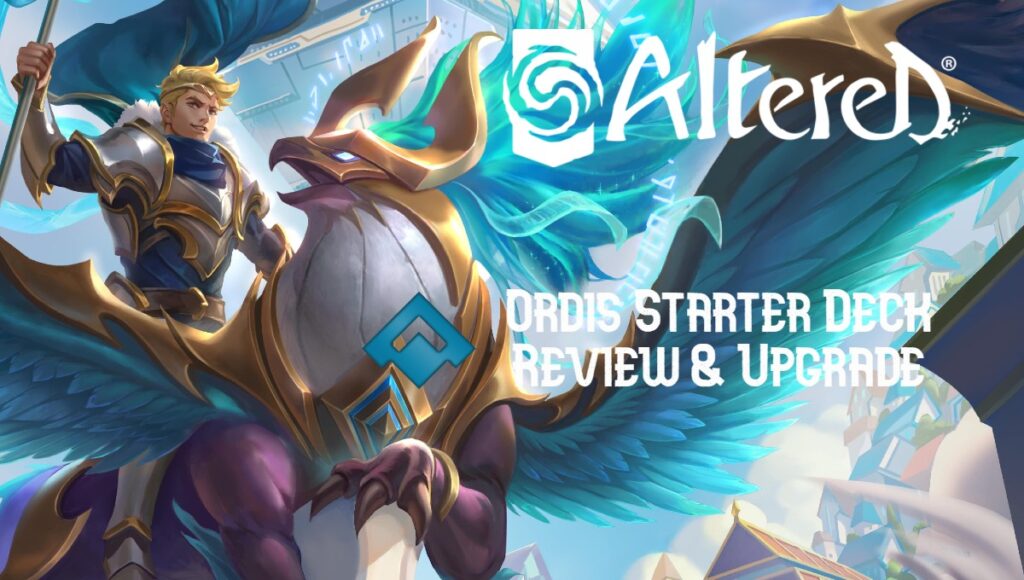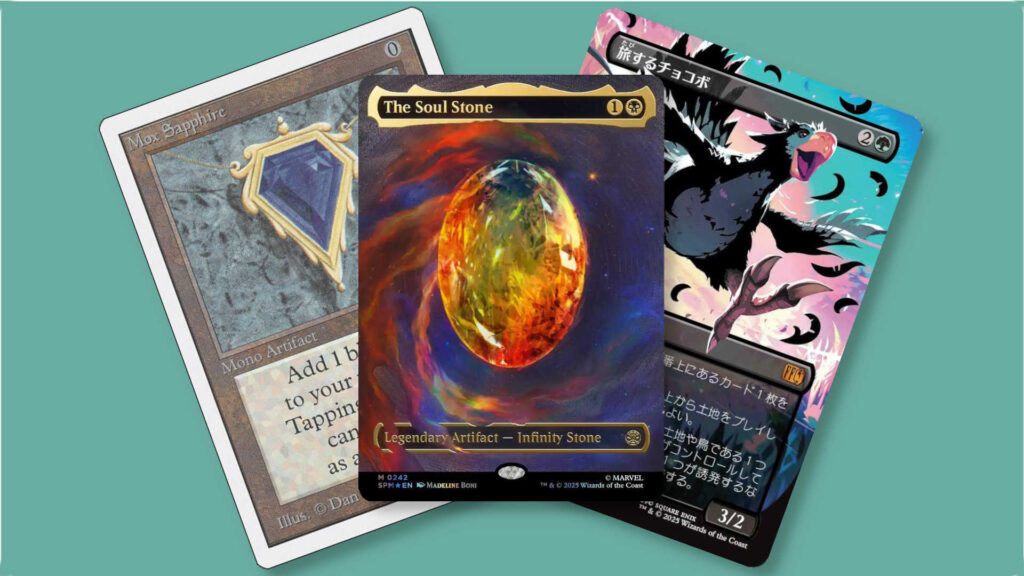Hello everyone and welcome back to Card Gamer’s ongoing series on reviewing and upgrading each of the six Starter Decks for Altered. This week we’re looking at the Ordis Starter and its included hero; Sigismar and Wingspan.
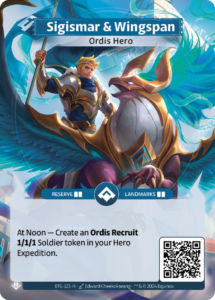
Of the six Starter Decks, Ordis takes the least work to turn into a competitively viable constructed deck, as it gives you almost every common you’d want to be running already. The Starter Deck focuses on Sigismar and Wingspan, the hero that I’d recommend to almost all new players due to how simple the hero is and the playstyle it promotes.
Unlike my Muna review, this will focus more on the starter deck and its strengths rather than diving into the upgrades, due to the vast amount of good, playable cards that it already has.
Table of Contents
ToggleOrdis Faction Overview
As a faction, Ordis is characterized by token-creation, cheap aggressive characters, and spells that care about having quantity over quality in characters. Board presence is largely more important than individual character quality, and both the premier removal and boosting spells support this. Ordis also obtains a lot of card draw in its faction-shifted spells, as well as an extensive suite of removal that it shares with Axiom and Yzmir.
Perhaps the biggest strength of the Ordis Starter Deck is the fact that, as a faction, it already possesses some of the best tools in the game without needing to seek out specific rares to “work” properly that some factions, such as Axiom, feel empty without. This all starts in the Starter Deck’s hero Sigismar and his ability to freely generate an Ordis Recruit token every single day in the hero expedition, allowing you to contest an expedition without committing a card to it, and also forcing the opponent to answer it to deny your free advancement.
Ordis Starter Decklist
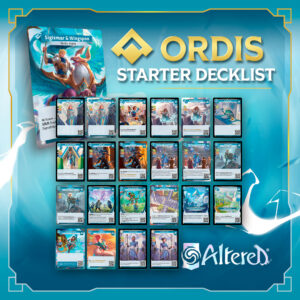
Here’s the complete decklist for the Ordis Starter Deck:
Hero
Sigismar & Wingspan
Characters
1x Jeanne d’Arc (r)
1x Foundry Mechanic (r,f)
1x Ratatoskr (r,f)
2x Ordis Trooper (c)
1x Ordis Trooper (r)
3x Ordis Cadets (c)
2x Monolith Rune-Scribe (c)
1x Monolith Rune-Scribe (r)
3x The Frog Prince (c)
3x Ordis Gatekeeper (c)
2x Ordis Spy (c)
1x Ordis Spy (r)
2x Kakoba, Legion Commander (c)
1x Kakoba, Legion Commander (r)
2x Jeanne d’Arc (c)
Permanents
3x Ordis Carrier (c)
3x The Monolith, Ordis Bastion (c)
Spells
3x Charge! (c)
3x Sticky Note Seals (c)
1x Open the Gates (r)
Characters
Many of the characters included in the Starter are ones you’d see in constructed Sigismar lists, from the cheap bodies like Ordis Trooper and Ordis Cadets, to interaction like Ordis Spy, and the top-end of more aggressive lists in Ordis Gatekeeper. However, the Starter Deck also contains some trap cards. Specifically I’m referring to the copies of Kakoba, Legion Commander, and Jeanne d’Arc, both of which read quite powerfully, especially the rare copy of Jeanne, but both feel underwhelming relative to what you could potentially be doing. Jeanne in particular feels bad in comparison to the Monolith landmark that’s also included in the Starter as they both reward you with a load of stats at the cost of essentially taking a whole turn off and allowing a double advance on the opponent’s end.
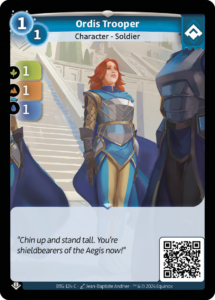
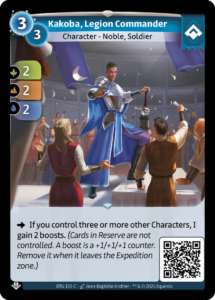
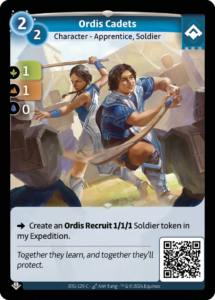
The main difference here is that the Starter Deck quite literally hints at and points you in the direction of what it would be like building a deck with Monolith’s cost in mind, including the faction-shifted Foundry Mechanic to show how you can reduce Monolith’s five mana to power it out earlier. The other difference is that Monolith’s bonuses are permanent in the form of boosts and synergize extremely well with Sigismar’s ability, while Jeanne instead makes tokens for the two turns it sticks around for and also wants Monolith while competing with it on the same turn you’d ideally develop it, as they both have similar hand costs.
Kakoba is similar, just really offering nothing but stats for having three or more other characters, akin to Muna’s Yong-Su. However, while Sigismar helps you get a third of the way there already, managing to get an additional two characters onboard before having enough mana left over to play out Kakoba just to get an undercosted 4/4/4 for the common seems like a very bad deal. If you were to play this card, I’d only really consider the rare in constructed lists.
Spells and Permanents
The lineup is again quite solid, with some cards that see play in many Sigismar lists, and provides a good jumping-off point to modify your Starter. Charge! in particular is an amazing card, and an Ordis staple as it is hard to play around with all the bodies being generated by Sigismar’s ability, Ordis Cadets, and Gatekeepers, and even then is hard to adequately defend against when telegraphed, making it both a great tool to get over the line in the later stages of the game or to beat out an aggressive start from the opponent. The Monolith, Ordis Bastion, as I alluded to earlier, is quite an amazing top-end for this aggressive token-based strategy and worth centering your deck around it.
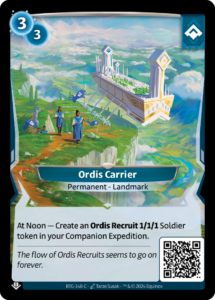
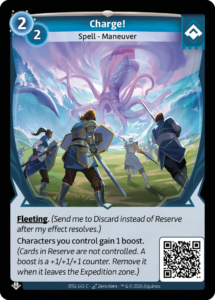
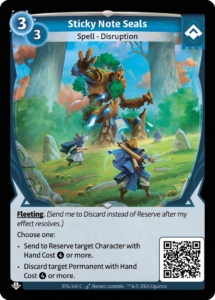
However, the remaining spells and permanents leave much to be desired. Ordis Carrier is an okay card to play in Ordis decks simply due to how powerful it can be to have it out on turn one, but the mana-to-stats ratio drops off of a cliff the later you see it in the game, so it really turns into a dead card when you’re essentially priced into playing three for the consistency of being able to see it in your opening hand more frequently. Sticky Note Seals is quite simply, a bad card that has a very niche goal; removing giant monsters in Muna or the occasional Brassbug Hive in some Axiom decks. Most of the time it’s a dead card that you feel forced to keep in your hand because they might have the one target that lines up with its requirements, which leads to gradual diminishing returns the longer it rots in your hand.
Similarly to Jeanne d’Arc, the rare Open the Gates really wants to be followed up by a Charge! or Monolith, but costing five mana means it’s a play that even when you can set it up to follow a Monolith or with a Charge!, you having to make the choice of distributing the tokens and then being tapped out for the entire turn lets the opponent play around your board accordingly and still potentially double advance on you.
That being said, the Ordis Starter’s raw power can’t be understated as Sigismar’s ability to put up a board presence, no matter how miniscule the Recruit token is, allows you to take a turn or two off to develop some of the five-cost cards while still contesting the hero expedition to a small degree. As a Starter Deck experience straight out of the box, it provides smooth gameplay and can play out of the occasional clunky hand due to the free token each turn. If you were to buy one starter deck, Ordis would be my top recommendation purely based on this.
Upgrades
This upgraded list that I’m suggesting revolves around trying to power out an early Monolith and taking over the game with the boosts it provides. There are definitely viable Sigismar lists that don’t make use of this landmark, opting instead for more characters to reduce awkward draws, but keeping Monolith in makes for fewer cuts from the Starter Deck and also showcases some of the synergies from the faction-shifted cards available in Ordis.
The Core:
3x Ordis Trooper (c)
3x Foundry Mechanic (r, f)
3x Ordis Cadets (c)
3x Ordis Spy (c)
3x Ordis Gatekeeper (c)
3x Frog Prince (c)
3x Charge! (c)
2x Sticky Note Seals (c)
3x Monolith (c)
The core of the deck is largely the same, and again, I’m trying to keep it to only nine rares so you can build upwards from there. As you can see, 26 cards are already in the Starter, which is a way higher amount compared to the Muna starter. Though I’m also treating the Ordis Troopers and Spies as being all common, you can simply play with the rare copies that come with the Starter Deck.
I know I ragged on Sticky Note Seals in my breakdown, but it certainly has a niche it fills against some specific matchups (the mirror, Axiom, and Muna come to mind), I just don’t think three is warranted to be playing in an aggressive deck that doesn’t want to play for a prolonged game. Axiom Mechanic is here primarily to discount Monolith and play it out earlier or allowing for additional plays after developing it.
The New Additions

3x Ozma (c)
3x Teamwork Training (c)
3x Kelon Burst (r,f)
3x Baba Yaga (r,f)
Ozma is a must-include in Sigismar, as it’s one of the few ways to cycle and does so both on being played from hand and out of reserve, something that, over the course of two turns, leads you to being up a card in hand. Teamwork Training is an absolute must in Ordis as it fulfils so much of what the deck wants to have access to in terms of a removal spell. While you’re often split on the use-cases of Kelon Burst and Sticky Note Seals, Teamwork Training scales as high as your characters in play and oftentimes does the same job as the other removal spells while costing one less.
Kelon Burst is faction-shifted over from Axiom again and functions as the deck’s removal for most of the commonly played characters in the game as well as sniping out annoying landmarks like The Spindle. Baba Yaga is also faction-shifted, providing a decent body for three mana. But more importantly it adds card draw to the deck, digging you deeper to the Monolith.
There’s one remaining slot left in the deck, and it can be a variety of things, though I’d recommend using one of the rares provided in the Starter Deck, like the Kakoba or the Monolith Rune-Scribe.
You may be asking why the faction-shifted Foundry Engineer isn’t being included here, and while it is a larger cost-reduction than the Mechanic’s, it doesn’t actually reduce the cost by anything if you factor in the fact that it costs two to play from reserve for a cost-reduction of two. If anything, it just makes the Monolith turn less of a free double advance for the opponent, whereas the Mechanic allows you to potentially play characters after the Monolith. Also, the difference between spending a whole turn to play out the Engineer and then the Monolith telegraphs the follow-up compared to the free reserve action of discarding the Mechanic means something like a Baku can’t break up your plans.
The final upgraded list will end up looking like this, and the gradual process of turning some of these commons into rares will only continue to boost the power of the deck.
The Upgraded Ordis List
Check it on Altered’s website here.
Hero
Sigismar & Wingspan
Characters
3x Ordis Trooper (c)
3x Foundry Mechanic (r, f)
3x Ordis Cadets (c)
3x Ordis Spy (c)
3x Ordis Gatekeeper (c)
3x Frog Prince (c)
3x Ozma (c)
3x Baba Yaga (r,f)
1x Monolith Rune Scribe (r)
Spells
3x Charge! (c)
2x Sticky Note Seals (c)
3x Teamwork Training (c)
3x Kelon Burst (r,f)
Permanents
3x The Monolith, Ordis Bastion (c)
Conclusion
The Ordis Starter is extremely strong – perhaps the strongest of the six factions out of the box – and only takes minimal upgrades to get to a decent power level with room for further growth. It has a straightforward game plan that’s easy to supplement and build around, and the synergies with all the Ordis cards are all appealing enough to include in your deck.
Check out our guides for the other starter decks here: Lyra, Axiom, Yzmir, Bravos, Muna.

